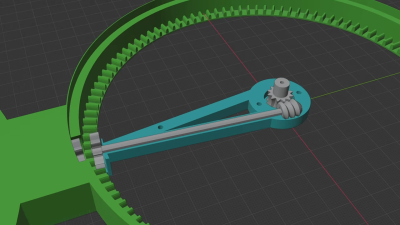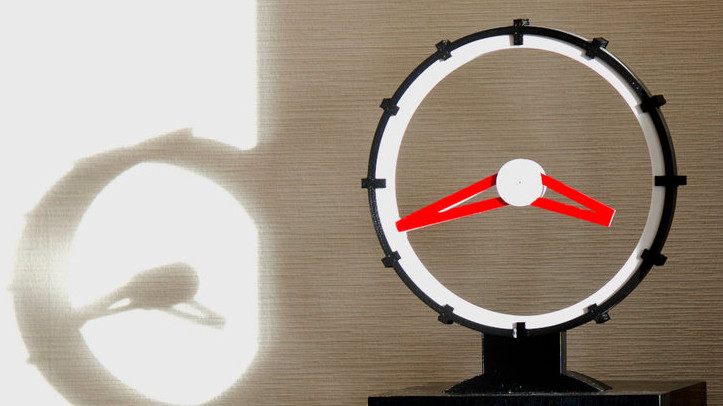[shiura]’s Hollow Clock 3 is a fantastic 3D printed take on a clock movement that uses a hidden mechanism to pull off its unusual operation. The Hollow Clock has no face, just an open space with an hour and minute hand that move as expected. Only the longer minute hand has any apparent connection to the rest of the clock body, with the rest appearing to hang in the air.

This is how it works: the longer minute hand is connected to the white ring, and it is in fact this ring that rotates, taking the attached minute hand with it. But how does the hour hand remain stationary while the rest turns? A concealed shaft and gear assembly takes care of that. For every full rotation of the minute hand (actually the white ring), the hour hand is only permitted a relative advancement of 1/12th of a rotation. It’s a clever system, and you can see the insides in the photo here.
Unlike clock projects that showcase their inner workings, the Hollow Clock works hard to conceal them. If you decide to make your own, [shiura] warns to expect to do a bit of tweaking to fine-tune the amount of friction between moving parts so that operation is smooth, and provides useful guidelines for doing so. Take a few minutes to watch the clock in action in the video, embedded below.
















Another way to do this might be to permanently fix the minute hand to the white part, and then use a mechanism in the base to spin the white part. Embed wires in the minute hand and then use a motor in the center to correctly keep the hour hand positioned. But this requires electronics to make work.
The minute hand is fixed to the white part! It saves the motor in the middle by having some smart gearing!
In the era of the cassette player and the VCR these backlash movement issues were solved with by using idlers with felt pads for friction. Now days you can buy felt pads / strips in a small kit at dollar stores,
That is amazing! I think where the minute hand meets the outer ring is just perfect so that you don’t even realize they’re touching. Brilliant!
Oops, threading fail… This was supposed to be a top level comment.
My parents had one of these when I was growing up during the late 50s:
http://www.roger-russell.com/jeffers/jefhour.htm
And the mechanism is simpler too. Gear in the base drives the glass pane with the minute hand attached, hour hand geared to the minute hand and just uses a ballast and gravity.
I had made another clock based on the gravity based mechanism similar to the Jefferson GoldenHour,
https://www.thingiverse.com/thing:4768343
Super cool!
Some one gave Ben Franklin one of these.
It is in the Ben Franklin Museum in Philadelphia.
I did not mean to diminish this project, I apologize if It sounded that way.
I could not have begun to duplicate it.
I also never saw how the one in the museum worked. It said someone gave it to Ben, but I don’t think the source was mentioned.
A family friend of mine had a desk clock in the late 80’s that was same form factor but had totally floating hands. The “trick” was that the hour hand was on a glass plate and rotated and some micro gears hidden in the hub spin the hour had around. I still think about that darn elegant clock like once a week.
Look at the next post up. Probably was made by Jefferson Electric.
Very cool
I wish i had a fraction of the mechanical design talent the people who make these amazing projects have.
This reminds me of the “impossible” clock that I think had magnetically levitated and controlled arms. I may be remembering it wrong but I can’t seem to find it on HaD. It was super impressive and if someone could link it, that would be awesome!
This is the first new take I’ve seen on this style in 150 years.
Robert Houdin, a magician horologist first created the idea, using glass disks inset into geared brass rings, to create a sethrough face with moving hands painted on the glass disks. His clocks are often called mystery clocks, and many have copied them.
This is a novel reimagining of that concept, bravo 👏
I was also impressed by the Robert Houdin’s series of mystery clocks, especially square one such as
https://www.liveauctioneers.com/news/wp-content/uploads/2021/01/Potter-Potter.jpg
Therefore I had made similar square mystery clock also with my 3D printer,
https://youtu.be/_5Mwxfsg_Og
https://www.thingiverse.com/thing:4770291
Again, very impressive. Thanks for sharing.
I’ve always liked clocks, especially those with unusual mechanisms. I don’t think I’ve ever come across this used elsewhere. I wonder if anyone has patented it. It’s certainly the sort of thing I’d buy/make myself.
This is hackaday at its best. Great article, as well as great, positive comments down here. It was a joy swinging by. Thanks everyone! ^_^